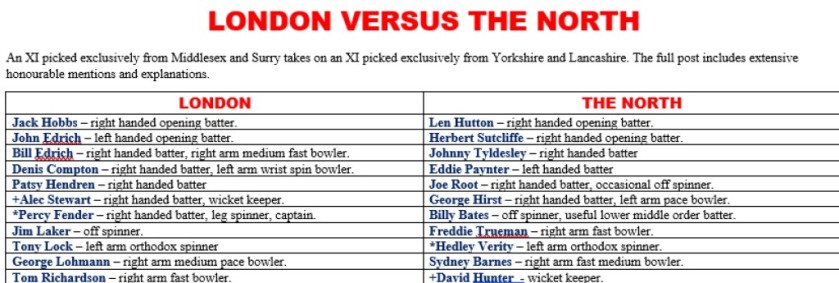INTRODUCTION
Welcome to today’s variation on an ‘all time XI‘ theme. Today features a battle between London and The North. I grew up in London, but have some northern ancestry and lived for a period in Barnsley, while I now live in Norfolk, so I consider myself decently equipped to handle this one.
THE BRIEF IN MORE DETAIL
For the purposes of of this post London means players from either Middlesex or Surrey. I am well aware that among the first class counties Kent and Essex also overlap with London. The Northern XI is drawn exclusively from Yorkshire and Lancashire, although there is an honourable mention for a Durham player. I have not included overseas players at all. Do check out my county XIs here.
LONDON ALL TIME XI
- Jack Hobbs – right handed opening batter. The man with more first class runs and more first class hundreds than anyone else who ever played the game (I go with the traditional figures of 61,237 runs and 197 hundreds). This is all the more remarkable, because having been born in Cambridge he had to serve out a two year qualification period before making his Surrey debut, and he also lost four years to Wiorld War 1. He ultimately became Sir Jack Hobbs, the first professional games player of any description to be knighted.
- John Edrich– left handed opening batter. Another scorer of over 100 first class hundreds.
- Bill Edrich – right handed batter, right arm medium fast bowler. A cousin of John. His test career got off to a slow start, but when he did manage a big score at that level it was seriously big – 219 versus South Africa at Durban, when England were baulked of victory by the weather and the necessity to return to Cape Town to get their boat home – they were 654-5 chasing 696 when time in what was supposed by a ‘timeless’ test match ran out.
- Denis Compton – right handed batter, left arm wrist spinner. Only Don Bradman reached the career landmark of 100 first class hundreds in fewer innings than Compton’s 552.
- Patsy Hendren – right handed batter, brilliant fielder. The second largest tally of first class hundreds, 170, and the third largest ever tally of first class tuns, 57,611, and he did all that while never forgetting that cricket was a game to be enjoyed. He took full advantage of playing for Middlesex – a record 75 of his first class hundreds were scored at ‘the home of cricket’.
- +Alec Stewart – right handed batter, wicket keeper. The man who scored more test runs than anyone else in the 1990s.
- *Percy Fender – right handed batter, leg spinner, captain. Exactly the right kind of player to be coming in at no7 in a very strong side, and an excellent captain.
- Jim Laker – off spinner. He was apparently capable of putting so many revs on the ball that it would hum in the air on its way to the batter.
- Tony Lock – left arm orthodox spinner.
- George Lohmann – right arm medium pace bowler. His test wickets came at 10.75 each, and a rate of one per 34 balls. He was joint quickest to 100 test wickets (17 matches, a record he shares with ‘Terror’ Turner).
- Tom Richardson – right arm fast bowler. The man who would walk from his home in Mitcham to The Oval carrying his cricket bag, bowl plenty of overs in the day and then walk back similarly encumbered. He nearly did a ‘Bob Willis’ at Old Trafford in 1896, when ‘Ranji’ had scored 154 to set the old enemy a victory target of 125 after England had been made to follow on. Richardson took 6-76 bowling unchanged, and Australia were relieved in the end to get home by three wickets.
This team has a super strong top five, a batter keeper at six, an all rounder who was also a very shrewd captain at seven and four well varied bowlers. Bill Edrich as third seamer can hardly be described as a weakness, given that he did on occasion take the new ball for his country, while Laker, Lock and Fender represent a fine spin trio.
THE NORTH
- Len Hutton – right handed opening batter, occasional leg spinner. His record looks even more extraordinary when you consider that he lost six years to World War Two, and a training accident during that conflict left him with one arm shorter than the other.
- Herbert Sutcliffe – right handed opening batter. He averaged 52.02 in first class cricket, 60.73 in test cricket and 66.85 in Ashes cricket, bearing out his famous comment “Ah Mr Warner, I love a dogfight.” His career was affected at both ends by war – World War 1 delayed his entry into first class cricket until he was 24 years old, while World War II finished his career – and in that last season of 1939 he had become the oldest player ever to carry his bat through a first class innings, so without the interruption he may well have carried on at first class level.
- Johnny Tyldesley – right handed batter. In the first decade of the 20th century only two professionals were selected for England purely on the strength of their batting, David Denton and Johnny Tyldesley. Tyldesley’s record was outstanding for a player of his era, and he was noted for his skill on bad wickets. He was also notably nimble footed, it being not unknown for him to deploy his favourite cut shot against balls pitched in line with middle stump.
- Eddie Paynter – left handed batter. He was baulked by the strength of Lancashire’s batting in his early years, but when he did reach the top he made it count, averaging 59.23 in test cricket, which included double centuries against Australia and South Africa.
- Joe Root – right handed batter, occasional off spinner. Note that I have not named him as captain because of his batting record while in that role, which is noticeably less good than his record before he became captain. It is his batting that I want, the same batting that saw him reach 3,000 test runs quicker than any other England batter.
- George Hirst – right handed batter, left arm pace bowler. This one caused me considerable thought, but his record was so good that, notwithstanding the roars of rage this decision will generate from folk based west of the Pennines I decided it had to be him. His 1906 feat of scoring 2,385 runs and taking 208 wickets in first class matches, echoed in miniature by his performance in the game against Somerset at Bath when he scored 111 and 117 not out and took six first innings wickets and five more in the second was a truly outstanding demonstration of skill and stamina – an equivalent in today’s much shorter first class season would be someone scoring 1,000 runs and taking 100 wickets in first class games, not an impossibility but certainly a feat that would be estraordinary, although anyone good enough to pull it off would very likely either be involved with England or spend some part of the season playing franchise T20 cricket somewhere else in the world.
- Billy Bates – off spinner, right handed lower middle order batter. He had a magnificent record until an eye injury brought a premature end to his career.
- Freddie Trueman – right arm fast bowler. No further comment needed.
- *Hedley Verity – left arm orthodox spinner. I have named him as captain, a role he never filled on the cricket field due to the prejudices of the era in which he lived, but which I believe he would have done splendidly. He did ultimately become a captain in a very different field – it was as Captain Verity of the Green Howards that he was fatally wounded in World War II. In less than a full decade of first class cricket prior to that he had captured 1,956 wickets at 14.90 each.
- Sydney Francis Barnes – right arm fast medium bowler. The man who took 189 wickets in 27 test matches at 16.43 each just has to feature.
- +David Hunter – wicket keeper. He was the keeper in the first truly great Yorkshire side, the one that dominated the early years of the 20th century, being champions five times in its first decade, including going unbeaten twice in 1900 and 1908.
This team has a formidable top five, one of the greatest of all allrounders, four excellent bowlers and a star keeper. There is a lack of leg spin, but otherwise all departments are well covered.
HONOURABLE MENTIONS
I am going to cover these in order by playing role:
- Opening batters – South: At least three other Surrey openers, Hayward, Sandham and Abel had outstanding records, while Andrew Strauss and Jack Robertson of Middlesex might also have their advocates.
- Opening batters – North: Percy Holmes of Yorkshire might be considered to recreate the great pairing of him and Herbert Sutcliffe, while Louis Hall and Jack Brown had fine records in an earlier era. Among Lancastrians, Cyril Washbrook and Mike Atherton were the two nost obvious candidates.
- Nos 3-5 – South: strong cases could be made for Ken Barrington and Peter May here, although bringing either in for Bill Edrich would change the balance of the side, and it is hard to envisage dropping Compton or Hendren. If told that I must accommodate Barrington on account of his test average of 58.67 I would do so by dropping John Edrich, and moving Bill up to open, a job he sometimes did in tests, slotting Barrington in at no3. Mike Gatting and Mark Ramprakash both had fine county records, but neither did enough at test level – Gatting averaged 35.55, and Ramprakash less than 30. ‘Young Jack’ Hearne might have got in on all-round talent. If Ollie Pope continues his career the way he has started it he will in due time command a place.
- Nos 3-5 North: Ernest Tyldesley of Lancashire scored over 100 hundreds, David Denton of Yorkshire warranted consideration, while more recently the Lancastrians Neil Fairbrother and John Craw;ey would have their advocates. Jonny Bairstow would have his advocates as well,and I might have created an extra slot by selecting him as keeper if I had full confidence in his glove work. Brian Close would also have his advocates.
- The all-rounder South: I have already mentioned ‘young Jack’, and Bernard Bosanquet was another candidate, as was Greville Stevens.
- The all-rounder North: Andrew Flintoff was an obvious candidate, and I did consider shelving the issue of transpennine rivalry by giving Ben Stokes of Durham the nod – he may yet make an already strong case irrefutable.
- Spinners – South: No other Surrey spinners rank wiht the two I chose, although Pat Pocock was a fine cricketer. Fred Titmus, Philippe Edmonds, John Emburey and Phil Tufnell would all have their advocates on the Middlesex side.
- Spinners – North: Ted Peate, Bobby Peel, Wilfred Rhodes and Johnny Wardle of Yorkshire were all possibles for the left arm spinner role, as was Johnny Briggs of Lancashire. For off spinners, Ted Wainwright, Bob Appleyard, Ray Illingworth and Roy Tattersall had fine records, although Wainwright had a disastrous tour of Australia in 1897-8.
- Pace bowlers South: Alec Bedser is the most obvious miss, but Gubby Allen also had a fine record, and Maurice Allom took a hat trick on test debut, although his overall record was not that great. Martin Bicknell had a superb county record and was unlucky not to get more chances for England. Bill Lockwood, who was also a useful batter, appears to have been the first to develop a slower ball as a variation, and by all accounts it was devilishly difficult to spot. Neville Knox’s pace was legendary but he only had two really good seasons, in 1906 and 1907.
- Pace bowlers North: Jimmy Anderson is the most obvious miss, but his huge tally of test wickets is down to longevity and the frequency with which test matches now take place more than to any special brilliance that he possesses. Brian Statham was a great bowler, but with Trueman and Barnes making irrefutable cases for selection there was no way to get him in without changing the balance of the side. Such luminaries as Schofield Haigh, George Macaulay and Bill Bowes, all magnificent bowlers, have to make do with honourable mentions, as to the two greatest Yorkshire quicks of the 19th century, Tom Emmett and George Freeman (209 wickets at 9.94 in first class matches). George ‘Happy Jack’ Ulyett was another early great, who could also have been considered as an all rounder.
- The Keepers – South: Had I been going to select a specialist keeper for the South rather than rely on Stewart there were two obvious choices, John Murray and Herbert Strudwick, with some 3,000 dismissals in first class cricket between them.
- The Keepers – North: apart from Jonny Bairstow, already mentioned for his batting, George Pinder, Joe Hunter (brother of David), Arthur Dolphin, Arthur Wood, Jimmy Binks and David Bairstow all had fine records for Yorkshire, while George Duckworth and Warren Hegg of Lancashire were both fine keepers.
There will doubtless be many more names that occur to readers, and do feel free to weigh in with comments.
THE CONTEST
The contest for what I shall jokingly call the ‘Watford Gap Trophy’ would be an absolute classic. I rate the London XI as stronger in batting, though not by much, but reckon that the Northern XI is somewhat better equipped in the bowling department. I cannot pick a winner here.
PHOTOGRAPHS
Having set up a fruity London vs The North contest, introduced the players and provided a detailed honourable mentions section it is time for my usual sign off…








































One thought on “All Time XIs – London vs The North”